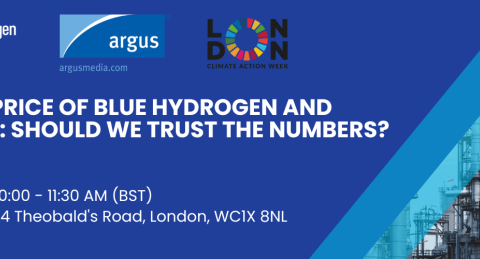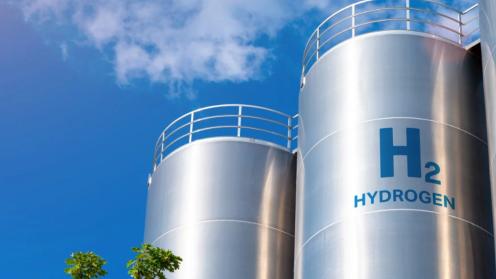Calling time on lazy references to cheap blue hydrogen - report launch on 23 June
📅 Join the launch of the report “In search of the real price of blue hydrogen”
Calling time on lazy references to cheap blue hydrogen. GH2 and Argus Media invite you to a critical discussion during London Climate Action Week, examining the gap between headlines and reality.
– Tim Hard, SVP of Energy Transition at Argus Media, will outline how Argus approaches ammonia pricing for blue and green ammonia, and how it evaluates data quality and market signals.
– Joe Williams, Deputy CEO, GH2, and Flore Schmerber, Policy and Research Associate, GH2, will present findings from the "In search of the real price of blue hydrogen" report, examining the assumptions behind widely cited cost and emissions estimates.
–Sharan Burrow, Chair of GH2, Alex Hewitt, Co-Chair of CWP Global, Kamlesh Parida, General Manager for Markets and Strategic Partnerships, Fortescue, and Lino Rodiek, Senior Manager at ReNew, will reflect, followed by a moderated discussion.

“UK blue hydrogen costs ease after £3/kg spike on natgas surge” (Quantum Commodity Intelligence)
There is just one problem with the headline above: UK blue hydrogen which meets the UK’s low carbon hydrogen standard does not actually exist.
For a clean energy solution that does not yet exist, the number of headlines in the press claiming that “blue hydrogen/ammonia is cheaper than green” has always perplexed us.
As we have said many times before, if blue hydrogen is to play a role in our net zero future it needs to be genuinely low carbon.
The emissions limits for blue hydrogen being put in place around the world vary in their stringency but will generally require blue hydrogen facilities to use autothermal reforming (ATR), achieve over 95% carbon capture, near-zero methane leakage and verified permanent CO2 storage.
We are all for technological progress and will give credit to large scale blue hydrogen facilities which achieve this level of emissions reduction performance.
Until then, it is essential that the low carbon hydrogen community caveats its claims around blue hydrogen pricing, especially as we see some projects fall by the way side such as BP’s decision this week to suspend plans for a blue hydrogen project at its Whiting Refinery in Indiana. There is a huge amount of uncertainty in the sector at the moment for both green hydrogen and blue hydrogen which also plays into price uncertainty. We are still waiting for the European Commission to adopt its contentious delegated act on Low Carbon Hydrogen and President Trump’s “One Big Beautiful Bill” (OBBB) looks set to largely decimate the US hydrogen production tax credit.
A report we are launching at an event hosted by Argus Media on Monday 23 June during London Climate Action Week called “In search of the real price of blue hydrogen” focuses on the misleading narrative that high quality blue hydrogen is readily available and cheaper than green hydrogen.
In fact, there are many reasons why a healthy dose of scepticism on the emissions reduction performance and price of truly low carbon blue hydrogen is warranted:
- While pricing agencies publish pricing assessments for blue hydrogen based on a reasonable set of assumptions, it is equally clear that many factors/variables will play into the true cost of producing blue hydrogen.
- Many assumptions such as the success of capturing, transporting and permanently storing 95%+ of the CO2 when stripping out the hydrogen from natural gas are yet to be validated in real world, commercial scale operations. CO2 transport and storage not just for blue hydrogen but in other applications such as CCS for cement making has never been attempted at the scale foreseen to reach net zero (one gigatonne of CO2 needs to be stored by 2030 according to the IEA).
- Performance uncertainty brings inherent price uncertainty. If I wanted to buy a new sports car based on its top speed, I would only buy it if I know that car has actually been driven at that speed before.
- Blue hydrogen projects will always depend on the volatility of natural gas prices. Supply and price shocks will flow through to blue prices – just look at the volatility we are seeing at the moment with the geopolitical uncertainty we are witnessing in the Middle East.
For those of us in the green hydrogen community, we are well aware of the need to drive down costs. There is still too much of a gap between the price of green hydrogen and that of unabated fossil hydrogen.
It is absolutely right that there is a high degree of scrutiny on the cost of green hydrogen.
All we are calling for is a similar level of scrutiny for blue hydrogen and an end to sweeping statements that blue hydrogen is cheaper than green. We may well end up with some high quality blue hydrogen which is cheaper than green hydrogen in certain contexts but until we have some real-world, large scale production of truly low carbon blue hydrogen, this rhetoric must stop.
Pricing agencies need to include health warnings highlighting the inherent uncertainty of blue hydrogen pricing, and those writing headlines based on those assessments need to include caveats and make clear they are writing about a product which does not yet exist.
US Hydrogen Policy at a Crossroads
The US risks locking in fossil-based hydrogen. Proposed changes in President Trump’s “One Big Beautiful Bill” would shorten the window for green hydrogen projects to access tax credits while loosening 45Q incentives for blue hydrogen — even when emissions reductions are questionable.
This shift would unfairly favour highly subsidised blue hydrogen, undermining transparency, distorting the market, and delaying the clean energy transition.
Joe Williams,
Deputy CEO, GH2
